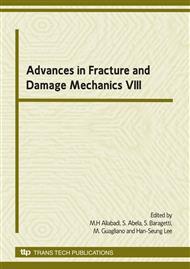p.485
p.489
p.493
p.497
p.501
p.505
p.509
p.513
p.517
Simulation of Delamination Using Discontinuous Galerkin Finite Element Methods and Cohesive Models
Abstract:
This paper presents a computational framework for simulation of delamination that combines the features of the discontinuous Galerkin methods with the versatility of the cohesive zone models. Within the finite element formulation of the discontinuous Galerkin methods, displacement discontinuities (jumps) are allowed across the element boundaries. Thus, the cracks are naturally included in the model without modifying the initial mesh. The displacement discontinuities across the element boundaries are used to compute the separations in the cohesive fracture law. The delamination initiation occurs when the traction across the element boundaries reaches its maximum; when the separation exceeds a critical value, total decohesion occurs. Numerical example is presented to illustrate the validity and effectiveness of the present methodology.
Info:
Periodical:
Pages:
501-504
Citation:
Online since:
October 2009
Authors:
Price:
Сopyright:
© 2010 Trans Tech Publications Ltd. All Rights Reserved
Share:
Citation:


